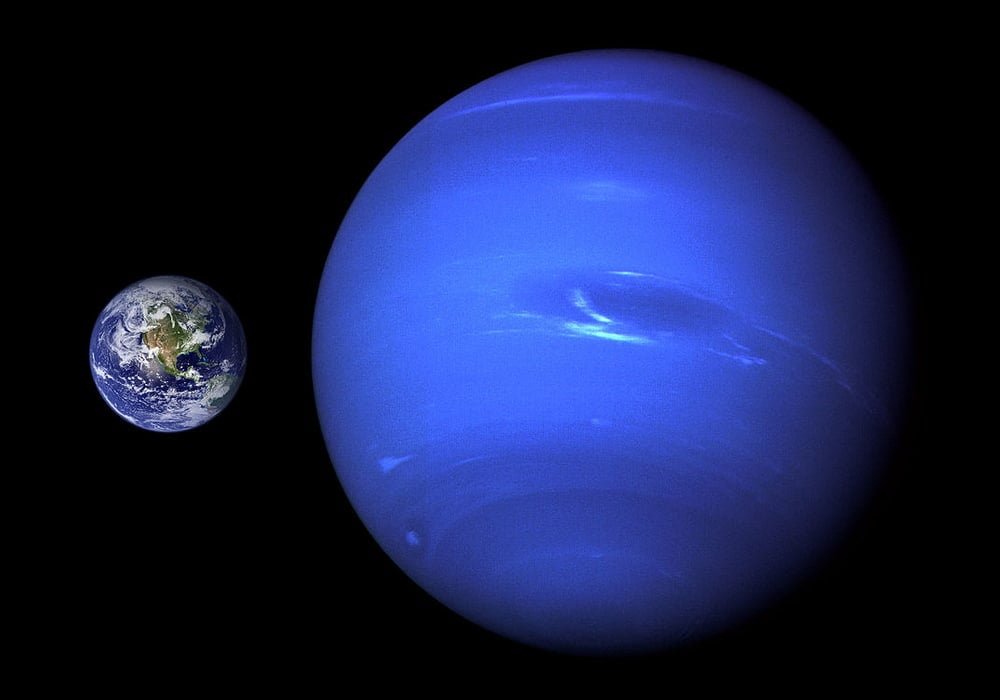Planet Neptune
Neptune is the eighth planet in order of distance from the Sun and the farthest known from the Solar System. It orbits the Sun at a distance of about 30.1 AU (4.5 billion kilometers), with orbital eccentricity half less than that of the Earth and a period of revolution of 164.79 years. It is the third most massive planet in the Solar System and the fourth largest in size – a little more massive but a little smaller than Uranus. Moreover, it is the densest giant planet.
Not visible to the naked eye, Neptune is the first celestial object and the only one of the eight planets in the Solar System to have been discovered by deduction rather than empirical observation. Indeed, the French astronomer Alexis Bouvard had noted unexplained gravitational disturbances in the orbit of Uranus and conjectured at the beginning of the nineteenth century that an eighth planet, more distant, could be the cause. British astronomers John Couch Adams in 1843 and French Urbain Le Verrier in 1846 independently calculated the predicted position of this hypothetical planet. Thanks to the latter’s calculations, it was finally observed for the first time on September 23, 1846 by the Prussian astronomer Johann Gottfried Galle, at one degree from the predicted position. Although Galle used Le Verrier’s calculations to discover the planet, the authorship of the discovery between Adams and Le Verrier was long disputed. Its largest moon, Triton, was discovered 17 days later by William Lassell. Since 2013, 14 natural satellites of Neptune have been known. The planet also has a weak and fragmented ring system and a magnetosphere.
The distance of the planet from the Earth giving it a very small apparent size, its study is difficult with telescopes located on the Earth. Neptune was visited only once during the Voyager 2 mission, which flew over it on August 25, 1989. The advent of the Hubble Space Telescope and large adaptive-optic ground telescopes then enabled additional detailed observations.
Like those of Jupiter and Saturn, Neptune’s atmosphere is composed mainly of hydrogen and helium as well as traces of hydrocarbons and possibly nitrogen, although it contains a higher proportion of “ice”. in the astrophysical sense, that is to say volatile substances such as water, ammonia and methane. However, like Uranus, its interior is mainly made up of ice and rocks, hence their name “ice giants”. In addition, methane is partially responsible for the blue tint of Neptune’s atmosphere, although the exact origin of this azure blue remains unexplained. In addition, unlike the hazy and relatively featureless atmosphere of Uranus, the atmosphere of Neptune exhibits active and visible weather conditions. For example, at the time of Voyager 2’s flyby in 1989, the southern hemisphere of the planet exhibited a Great Dark Spot comparable to the Great Red Spot on Jupiter. These weather conditions are driven by the strongest winds in the Solar System known, reaching speeds of 2,100 km / h. Due to its great distance from the Sun, its outer atmosphere is one of the coldest places in the Solar System, with cloud top temperatures approaching 55 K (−218.15 ° C).
The planet is named after Neptune, god of the seas in Roman mythology, and has the astronomical symbol ♆, a stylized version of the god’s trident.
Atmosphere of Neptune
Neptune’s atmosphere, more than 8,000 km (4970,97 miles) thick, is composed by volume of about 80% hydrogen and 19% helium with around 1.5% CH4 methane – the fact that the sum is more than 100% is due to the uncertainties about these proportions. Traces of ammonia (NH3), ethane (C2H6) and acetylene (C2H2) were also detected. Its atmosphere forms about 5% to 10% of its mass and represents 10% to 20% of its radius.
The blue color of Neptune comes mainly from methane which absorbs light in the wavelengths of red.
| Atmosphere | |
|---|---|
Scale height | 19.7±0.6 km |
| Composition by volume |
|
Climate of Neptune
Neptune’s weather is characterised by extremely dynamic storm systems, with winds reaching speeds of almost 600 m/s (2,200 km/h; 1,300 mph)—nearly reaching supersonic flow in the planet’s atmosphere – where the speed of sound is twice as large as on Earth. These winds are also the fastest in the Solar System.
By following the movement of the persistent clouds, it has been observed that the wind speed varies from 20 m / s when going east to 325 m / s when going west. At the top of the clouds, the prevailing winds vary in speed from 400 m / s along the equator up to 250 m / s at the poles. Most of the winds on Neptune move in a direction opposite to the planet’s rotation. The general wind pattern also shows prograde rotation at high latitudes versus retrograde rotation at low latitudes. This difference in flow direction would be a kind of skin effect and not the result of deeper atmospheric processes.
Neptune differs greatly from Uranus in its typical level of meteorological activity. Indeed, it was not observed any comparable phenomenon on Uranus according to the observations of Voyager 2 in 1986.
The abundance of methane, ethane, and acetylene at Neptune’s equator is 10 to 100 times greater than at the poles. This is interpreted as evidence of phenomena similar to an upwelling at the equator caused by winds and then a plunge of water near the poles. Indeed, photochemistry cannot otherwise explain the distribution without meridian circulation.
In 2007, it was discovered that the upper troposphere at the south pole of Neptune is about 10 degrees warmer than the rest of its atmosphere, which has an average temperature of about 73 K (−200.15 ° C). The temperature differential is sufficient to allow methane, which is frozen elsewhere in the troposphere, to escape into the stratosphere near the pole. This relative hot spot is due to the axial tilt of Neptune, which exposes the south pole to the Sun during the last quarter of Neptune’s year, or about 40 Earth years. As Neptune slowly moves to the opposite side of the Sun, the south pole becomes darkened and the north pole illuminated, causing this hot spot to shift towards the north pole.
Due to seasonal changes, with the planet entering its spring in its southern hemisphere, Neptune’s southern hemisphere cloud bands increase in size and albedo. This trend is observed for the first time in 1980, and should last until the 2020s, because of the seasons that last forty years on Neptune due to its long period of revolution.
Time of Evolution
The rotation time of the Planet Neptune is 16.1 hours. Which means, when compared to Planet Earth, in one day it rotates fully in 16.1 hours. When the revolution is 164,788 years.
Which means that one year on the planet Neptune is 164 years and 9 months old according to Earth’s time calculations.
For example, if we are 25 years old on Earth according to Earth’s time, then on Neptune our age is 1 month and 25 days. Conversely, if we are Neptune humans and are 25 years old, then if we are on Earth and calculated according to Earth time measurement, then our age is equivalent to 4 120 years according to Earth time measurement.
Out of nothing, but quickly adopted
In astrology, Neptune rules the sign of Pisces. Out of opportunism, since Neptune did not appear in our conscious universe until 1846! Let us say right away that the new planet did not cause procrastination like Uranus.
On the contrary, without precondition, all the peoples gave it a similar name, in connection with the world of the oceans and often the name of the gods of the water and the sea of their respective cultures. This choice apparently comes from its beautiful ultramarine color and its unfathomable distance.
The needle in the haystack (a large, tall pile of hay in a field)
Seventeen times the size of Earth, but of magnitude 7.8, Neptune is invisible to the naked eye and only the invention of the telescope will have made it possible to observe it. It would have been a miracle to stumble upon it by chance. Its orbit is immense, almost circular, but more than four and a half billion kilometers.
Neptune has traveled it in more than 164 years. Finding it by knowing its position remains delicate, and even illusory without knowing where to look. What happened to Uranus, about twice as close, almost happened. Galileo observed it in 1612 and recorded a star in his sketches. He will observe it exactly a month later, slightly shifted, but that will not alert the great scientist.
Neptune will be observed a century and a half later by De Lalande and by Herschel, the discoverer of Uranus, still without conclusions. Finding something invisible that isn’t meant to exist in the middle of nowhere: it’s a challenge.
An unprecedented deduction from science
As a sign of new times, it is mathematicians who will discover Neptune. Now scientists are starting to specialize, science is doubting itself and always looking for proof. The orbit of Uranus is intriguing. It deviates from the updated forecasts: the model is incomplete.
An attempt by Delambre adds the gravitational influence of Jupiter and Saturn. It is better, but unsatisfactory: the tables patiently drawn up by astronomer Bouvard remain wrong by half an arc minute. It’s not much, but it’s too much. Two schools clash: questioning the model of universal gravitation, sorry, or the existence of a transuranic planet.
Scientific competition and interdisciplinary collaborations
The existence of another planet wins general support, and a blind race begins between English and French.
The English fired first: Adams determined on October 21, 1845 an orbit two degrees from that of the future Neptune, but the Royal Astronomer Sir Airy was not convinced and did not make official.
At the same time, François Arago, director of the Paris observatory, mandated the mathematician Urbain Le Verrier who published his first results on November 10, 1845. Noticing them, Airy commissioned the astronomer Challis to carry out very ambitious research based on new data from Adams .
Le Verrier called on the German astronomer Galle from the Berlin Observatory, who found Neptune almost immediately on September 23, 1846, to a degree close to the predicted position. Its main satellite Triton will be observed shortly after.
The hapless Challis learns from the press and discovers that he had observed the planet twice in August, unfortunately without official publication. The paternity controversy will be settled scientifically, with Le Verrier’s results proving to be less imprecise and divergent than those of Adams.
The radius of Neptune’s orbit is exactly 30.1 AU with an eccentricity less than 0.009. Le Verrier having passed to posterity, let’s continue our historic cabotage.
An uncertain podium
Much later, scientists found the distant Pluto, considered from 1930 until late as the ninth planet. Well almost. Pluto’s very elliptical orbit intersects with the almost circular orbit of Neptune, which was transient from 1979 to 1999 the ninth planet.
The discovery in 1992 of the Kuiper belt sparked a debate on the status of Pluto which could be part of it. In 2006, Pluto was officially classified as a dwarf planet, Neptune the eighth and final planet, until the eventual confirmation of a ninth planet subodorized by certain calculations.
Direct observation remains difficult, and few elements of knowledge are added: three moons and suspicions of the presence of rings. Lots of mistakes too, including the “discovery” of chlorophyll, and possibly plant life. An effect of the orthochromatic plates used. Let’s be careful with the artist’s views of exoplanets!
Neptune’s only visitor: Voyager 2
The great advance will come from Voyager 2, which will approach in 1989 to some 29,000 km and will make a harvest of data: ten new moons, confirmation of very thin rings, measurement of a magnetic field, winds of 2000 km / h , clouds and the famous dark spot considered to be a huge cyclone.
The rotation time will be set at 4:11 p.m. A handicap limits this operation: the transmission time virtually prevents interaction on the mission. We could only enrich the pictures of the Proteus moon spotted early enough.
With the overflight of Triton having been preprogrammed, the probe was able to specify its diameter, detect a thin atmosphere, traces of slight volcanism, and the coldest surface temperature ever measured in the solar system, 38 ° K. In all, we have already counted fourteen satellites of Neptune.
An overflowing activity
Hubble will take over, and three images taken in 1994 indicated significant atmospheric activity. The large dark spot was gone, but a large dark spot from the north will be visible for a few years in the other hemisphere.
A significant differential rotation could be measured between the equator, 6 p.m., and the poles, 12 p.m. Neptune has an almost banal tilt, 28 ° 32, close to that of Mars or even Earth.
So there are four seasons, but about forty years. It’s summer right now, and it’s 55 ° K, or -218 ° C. Neptune would not be telluric. Its composition would be close to that of Uranus, a solid core the size of the Earth, an icy medium layer to fluid composed of water, methane and ammonia, finally a thick atmosphere of hydrogen and helium in fairly classic proportion.
Under pressure and temperature conditions, carbon follows a particular cycle of release of hydrocarbons, of precipitation in the form of diamonds floating on liquid metallic carbon. Probably no beaches bordering this inhospitable ocean. Even clouds do not make you dream: certainly methane crystals arranged in immense equatorial bands.
List of questions for a birthday
It’s been a little over 164 years: Neptune has just returned to the area where it was discovered and many peculiarities remain unexplained. We have been able to detect the presence of magnetic aurorae.
The rather weak field is eccentric and very inclined at 47 °, because certainly produced by the non-solid mantle. The five rings, reddish, are thin, but continuous, probably made up of dark microparticles of ice mixed with carbonaceous compounds. Two are wide, the others narrow, including the Adams ring which is made up of stable shining arches of a still unexplained nature.
Triton has the distinction of being retrograde, which is exceptional for its size, seventh in the solar system. Perhaps he was captured by Neptune from the Kuiper Belt. A rare case, it continues to get closer: will it end up in a ring?
Neptune emits nearly three times as much energy as it receives – 900 times less than Earth. The seasons and this still unexplained internal heat must be the cause of the strong winds observed, the fastest in the solar system, dark spots that make and unravel, and a super fast cloud, called a “scooter”.
This activity still deserves a lot of study. Neptune could contain Hitler’s Acid, a nickname for the hypothetical orthocarbonic acid, which would call into question many assumptions about its nucleus.
Neptune blue comes mainly from methane, but which should give a color close to that of Uranus. Substances that give Neptune’s own beautiful hue have not yet been identified. It might be a good thing to keep a little bit of mystery for her Neptunian birthday.
Neptune rules Pisces
This planet recalls the dreamlike world, dreams, the sometimes exacerbated ideology that can touch the extremes, feelings and other feelings not always easy to understand which can destabilize the inner worlds. It can also be synonymous with addictive behavior, personality disorders. The element associated with Neptune is Water.
In a positive contribution, Neptune can reflect instinct, psychological finesse, well-channeled intuition but also notoriety and creative genius.
In a negative approach, she highlights dependencies, the harmful influence of those around them, the absence of regulation, cowardice and the fact of preferring dreams to reality.
Neptune is the planet of Pisces, that is to say people who shine with their imagination, their sensitivity, their inspirations. Very utopian, they sometimes get lost in illusions, far, very far from any reality.
Sources: PinterPandai, NASA Science, Space Facts, The Planets
Photo credit: Wikimedia Commons
Photo explanations: Planet Neptune compare to Earth.



